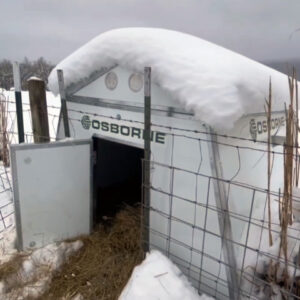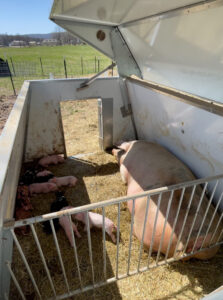As a livestock farmer, you understand the time between birth and weaning is often associated with the highest mortality losses, especially with pigs. As a way to reduce those mortality rates, indoor confined farrowing stalls have become the preferred way to offer more protection and optimize farrowing. In more recent years, however, as producers rediscover alternative pig production methods, farrowing in open spaces is beginning to trend upward once again. Outdoor farrowing, for example, which was primarily done in the last century, is one form of open space farrowing, and the technique and its benefits continue to be explored and reexplored.
Despite the assumption that “outdoor farrowing” implies the birth takes place outdoors, some form of enclosure or farrowing “hut” is still often required for the sow to use while nesting, giving birth, and for the handful of days that follow.
Benefits of Outdoor Farrowing
 While outdoor farrowing practices may not work for all hog breeding operations, some producers have recognized its benefits, which include:
While outdoor farrowing practices may not work for all hog breeding operations, some producers have recognized its benefits, which include:
- A lower capital investment and cost of production
- A more natural environment for the sow and piglets
- An atmosphere that allows the sow to build a nest, forage, and move around freely
- A reduced level of noise outside compared to inside, which reduces stress (UCANR)
Successful Outdoor Farrowing
In an ideal scenario, farrowing is considered to be successful if there around 10 healthy piglets in the litter. In order to increase the chances of a fruitful litter and healthy birthing process for the sow, there are some important steps you can take, including:
Sow Preparation
Even before the sow breeds, it’s crucial that you pay special attention to the health of the sow. This means ensuring that she is in good physical condition and is being provided proper nutrition. The sow should also be up to date on any preventative treatments to minimize the risk of her spreading any detrimental illness or pathogen to the newborn piglets.
Once the sow’s health is optimal for breeding, you can set a breeding date. If you want farrowing to begin by a certain month, allow for the total days of gestation and be sure to transfer the sow to her farrowing area by the 110th day.
Housing Preparations
The outdoor housing unit for the farrowing process should be well cleaned and ready for use well in advance. The “hut” will have to provide enough warmth to support the sow’s and piglets’ thermal neutral zone. Every pig farmer across the U.S. will have varying outdoor farrowing weather conditions depending on the time of year and location. For those who plan to continue breeding and farrowing around the colder months of the year, setting up the proper housing unit is crucial to keeping the sow and her piglets safe and healthy.
The Osborne Hog Hut farrowing house was designed with insulation to create a more temperature-controlled environment despite drops in outdoor temperatures. With corrosion-resistant, fiberglass-reinforced structural panels for the flooring, sides, and roof, the Hog Hut offers adequate space, and even includes a protected creep area for the newborn pigs.
Assisting During Farrowing
Most pig farmers have found that being present for farrowing can help improve piglet survivability and reduce complications like piglets being crushed or having trouble exiting the birth canal.
On average, you can expect piglets to arrive only minutes apart from each other and labor to last up to several hours. Most healthy piglets are able to stand up within just a couple of minutes and will be ready to nurse from the sow.
Contact Us
For more information on farrowing pigs outdoors and the solutions Osborne offers to make outdoor farrowing effective and efficient, contact us today!



